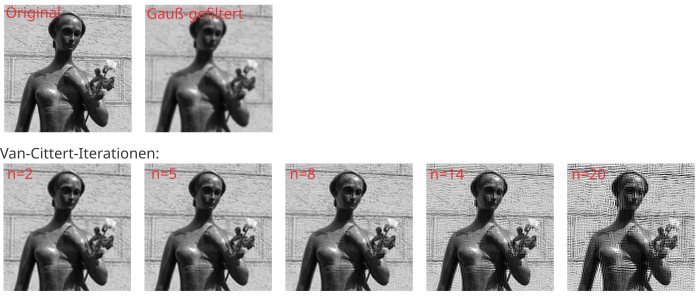Van Cittert deconvolution
The Van Cittert deconvolution (named after Pieter Hendrik van Cittert ) is a procedure to reverse the convolution of an image g with a filter mask (PSF) h ( deconvolution / inverse filtering). It can be used to improve the image quality if the image has been "washed out", for example by a blurred lens or the like. The image g represents the ideal image that one would like to obtain as a result of the method. The blurred image f , which is the starting point of the procedure, is described by:
Here corresponds to the filter operator represented by convolution with h . The aim is to calculate the following expression:
The Van-Cittert deconvolution approximates this using an iterative formula:
There is an operator whose point response I corresponds to a delta pulse (0 everywhere, 1 only in the middle). So the operation just gives . The strength of the aliasing depends on the number of iteration steps k . The more iteration steps are carried out, the stronger the refolding (sharpening). In return, the image noise is increased if the number of iterations is too large and the image becomes indistinct again.
example
The following images show the application of the Van Cittert iteration to a blurred image (3 × 3 Gaussian filter):
Derivation
In Fourier space the convolution becomes a point-wise multiplication, so that:
This is easy to calculate if the transfer function does not contain any zeros, as otherwise division by 0 would be necessary. To get around this problem one introduces . This then applies:
In the last step a Taylor development was carried out. The term is developed around the invariant mapping , or . In the local space this expression results:
- with .
Using the Horner scheme for this polynomial, the above iteration rule is obtained:
literature
- PH van Cittert: On the influence of the slit width on the intensity distribution in spectral lines. II . In: Journal of Physics . tape 69 , no. 5 , May 1, 1931, p. 298-308 , doi : 10.1007 / BF01391351 .
- Bernd Jähne : Digital image processing. 6th edition, Springer, 2005, ISBN 3-540-24999-0 .


















